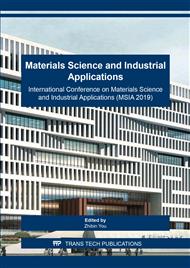[1]
Liu Y. Z. Prospects for PVAc emulsion industry in 2000[J]. China Adhesives, 1994, 3(4):8-11.
Google Scholar
[2]
Kong X.Z., Ruckenstein E. Core–shell latex particles consisting of polysiloxane-poly (styrene-methyl methacrylate-acrylic acid): Preparation and pore generation[J]. Journal of applied polymer science, 1999, 73(11):2235-2245.
DOI: 10.1002/(sici)1097-4628(19990912)73:11<2235::aid-app21>3.0.co;2-0
Google Scholar
[3]
Wang L.p., Wei Z. Study on co-polymerization modification of VAc homopolymer emulsion - emulsion co-polymerization of VAc and five types of monomer[J]. Journal of Beijing Forestry University, 1994, (04): 85-91.
Google Scholar
[4]
Chen H.S., Sun Z.Y. Preliminary study on white emulsion modified by nano-SiO2[J]. Science & Technology in Chemical Industry, 2000, 8(5):33-37.
Google Scholar
[5]
Xue P. Study on waterborne polyurethane adhesive[D]. Hefei University of Technology, (2013).
Google Scholar
[6]
Liu H.Y. Basic study on water resistance of PVAc emulsion [D]. Northeast Forestry University, (2008).
Google Scholar
[7]
Dai Z. Synthesis and properties of waterborne polyurethane modified by epoxy and crylic acid [D]. Anhui University, (2011).
Google Scholar
[8]
Liu J.C. Study on synthesis and application of room temperature self-crosslinking core-shell structure acrylic ester emulsion [D]. South China University of Technology, (2010).
Google Scholar
[9]
Mustafaraj G, Chen J, Lowry G. Development of room temperature and relative humidity linear parametric models for an open office using BMS data[J]. Energy and Buildings, 2010, 42(3): 348-356.
DOI: 10.1016/j.enbuild.2009.10.001
Google Scholar


